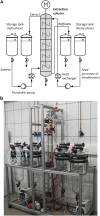A Downstream Processing Cascade for Separation of Caproic and Caprylic Acid from Maize Silage-Based Fermentation Broth
- PMID: 34527660
- PMCID: PMC8436119
- DOI: 10.3389/fbioe.2021.725578
A Downstream Processing Cascade for Separation of Caproic and Caprylic Acid from Maize Silage-Based Fermentation Broth
Erratum in
-
Corrigendum: A downstream processing cascade for separation of caproic and caprylic acid from maize silage-based fermentation broth.Front Bioeng Biotechnol. 2022 Oct 12;10:1049451. doi: 10.3389/fbioe.2022.1049451. eCollection 2022. Front Bioeng Biotechnol. 2022. PMID: 36312542 Free PMC article.
Abstract
Production of caproic and caprylic acid through anaerobic fermentation of crops or residual and waste biomass has been regarded as an alternative to the conventional ways, where plant oils and animal fats are mostly used. The downstream processing of the fermentation broth is a particular challenge since the broth has a highly complex composition and low concentrations of the target products. In this study, the proof-of-principle for a separation cascade for caproic (C6) and caprylic acid (C8) produced in a maize silage-based fermentation process was demonstrated. For clarification of the fermentation broth, a filter press and a ceramic ultrafiltration membrane was used to remove coarse solids and to separate suspended particles and macromolecules from the fermentation broth, respectively. With both techniques, the dry matter content was reduced from 6.8 to 2.3% and a particle-free product solution was obtained. Subsequently, the carboxylic acids were extracted with oleyl alcohol by liquid-liquid extraction with an extraction efficiency of 85% for C6 and 97% for C8. Over the whole cascade, 58% of caproic acid and 66% of caprylic acid were recovered from the fermentation broth into the extract. Among all separation steps, solid-liquid separation with the filter press caused the major part of the product loss of 21% of each carboxylic acid. By using separation equipment with a better solid separation efficiency such as decanter centrifuges or belt filter presses this loss could be minimized.
Keywords: anaerobic fermentation; biorefinery; chain elongation; liquid-liquid extraction; medium-chain carboxylates; ultrafiltration.
Copyright © 2021 Braune, Yuan, Sträuber, McDowall, Nitzsche and Gröngröft.
Conflict of interest statement
The authors declare that the research was conducted in the absence of any commercial or financial relationships that could be construed as a potential conflict of interest.
Figures







References
-
- Aghapour Aktij S., Zirehpour A., Mollahosseini A., Taherzadeh M. J., Tiraferri A., Rahimpour A. (2020). Feasibility of Membrane Processes for the Recovery and Purification of Bio-Based Volatile Fatty Acids: A Comprehensive Review. J. Ind. Eng. Chem. 81, 24–40. 10.1016/j.jiec.2019.09.009 - DOI
LinkOut - more resources
Full Text Sources

